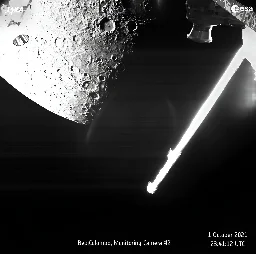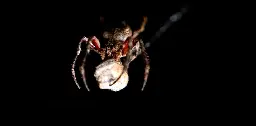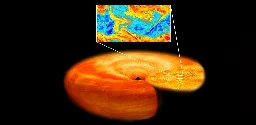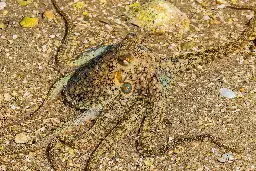
Jingszo !
- UFO Encounter Labeled 'Best Documented' Nearly Melted Man: Falcon Lake Incident Explainedpopculture.com UFO Encounter Labeled 'Best Documented' Nearly Melted Man: Falcon Lake Incident Explained
This encounter left the man marked by the burns, including his melted gloves.

This encounter left the man marked by the burns, including his melted gloves.
No matter what you believe about the nature of "flying saucers," there is one sighting labeled the "most convincing" UFO encounter in history. According to CBC, the Falcon Lake incident in Canada is being called the "best-documented UFO case" 50 years after the actual event.
According to the account, Stefan Michalak was in the woods when he encountered a pair of "cigar-shaped objects" nearby, changing hues while floating before taking a disc shape. Michalak started drawing what he saw, which made their way online years later, before trying to get closer to the object.
"He couldn't make out any words, or anything, but he heard at least two beings communicating inside. He called out, offering mechanical help if they needed it," the It Gets Weird podcast recently detailed. "As soon as he touches the craft, the fingertips just start to melt, so it's so hot that it literally melts the gloves he's wearing...He's hit by this blast of air, that pushes him backward and sets his shirt and hat on fire. He's stumbling backward, getting pushed by this wave of air and gas, and trying to take this burning shirt and hat off."
The account goes on to say he showed symptoms of radiation sickness and had "severe burns" on his torso that look like a grate or Bingo card. Once released from the hospital, he returned to the locale to recover his "charred shirt, a melted glove and tools he'd left behind." He maintained his story until dying in 1999, never saying he encountered little green men either.
- Shields Up! Lunar Swirls Arise from Ancient Underground Force Fields on the Moonwww.scientificamerican.com Shields Up! Lunar Swirls Arise from Ancient Underground Force Fields on the Moon
Wispy whorls on the moon’s surface are as lovely as they are strange. Scientists are starting to unravel their origins

For centuries, a mystery has been hiding in plain sight on the surface of the moon: bright, sinuous swirls that sprawl across thousands of square kilometers of the lunar landscape, visible through telescopes on Earth but defying explanation.
Now, at last, scientists are starting to understand them—and it turns out they’re weirder than anyone would have imagined.
These enigmatic “lunar swirls” are the result of ancient underground force fields that shield the moon from barrages of subatomic particles blasted out by the sun. Each swirl is a meandering blanket of pristine rock interlaced with darkened, radiation-zapped material.
Unlike Earth, the moon today doesn’t have a global magnetic field. It had a weak one billions of years ago, when it was still molten, but that died down quickly as the moon cooled. As rocks solidified on the surface, however, they were able to retain some of that ephemeral magnetism, creating more enduring localized regions with a somewhat stronger magnetic field. Given their ancient origin, these are called “relic” fields, and many are associated with lunar swirls.
The actual reason for this association became clear about a decade ago, when scientists published results in Nature Communications that showed that the relic fields around swirls, weak as they are, can still be strong enough to slightly deflect the solar wind impinging on the lunar surface. This wind consists of subatomic particles from the sun, and the trajectories of electrically charged particles such as electrons and protons can be changed by magnetic fields.
Where the relic fields are stronger, the particles veer off to the side, darkening the ground where they fall—and leaving curiously curlicue patterns in the more pristine magnetically shielded surface.
- Why Voltaire Drank Bull’s Bloodwww.atlasobscura.com Why Voltaire Drank Bull’s Blood
Bull’s blood isn’t poisonous; so why did people think it was for centuries?
As described in his Philosophical Dictionary in 1764, Voltaire conducted this peculiar experiment to dispel an equally strange, yet persistent, myth dating back to ancient times: that bull’s blood was a deadly poison.
“If a man in his folly tastes the fresh blood of a bull, he falls heavily to the ground in distress, over-mastered by pain,” the Greek physician Nicander wrote in the second century BC.
Nicander was echoing earlier Greek writers like Aristotle, who described bull’s blood as the “quickest to coagulate” of all animal bloods (a claim unsupported by modern research, which has found that the blood of cattle clots more slowly on average than that of some other animals such as pigs and sheep).
However, Ancient Greek scholars believed that bull’s blood solidified rapidly in the throat when swallowed, causing fatal asphyxiation. “The blood congeals easily,” Nicander explained, “and, in the hollow of [the victim’s] stomach, clots; the passages are stopped, the breath is straitened within his clogged throat, while, often struggling in convulsions on the ground, he gasps bespattered with foam.” To treat this gruesome condition,
Nicander recommended several remedies, of which some (fresh figs in vinegar) sound easier to obtain than others (the milk of a hare or deer).
- Meet the Bone-Eating Vulture That Dyes Itself the Color of Bloodwww.atlasobscura.com Meet the Bone-Eating Vulture That Dyes Itself the Color of Blood
You don't get more hardcore than the lammergeier.

Vultures are not always the most visually appealing birds. But bearded vultures, or lammergeiers, are beautifully done up, with glossy dark wings, long thin goatees, and KISS-worthy eye masks. Their chests, heads, and legs are especially impressive, colored the rich red brown of polished mahogany. They deserve much of the credit for their fashion sense. These vultures turn their feathers red on purpose, covering themselves in iron oxide by bathing in rusty water or rubbing themselves with damp red soil.
They are the only birds known to intentionally color themselves, and exactly why they do is still not entirely settled.
Lammergeiers eat almost exclusively bones—the last remnants of the meals of other scavengers. Bones from anything smaller than a sheep they can eat whole. They’ll fly larger ones high into the air and drop them onto rocks over and over again until they break up into swallowable pieces.
- Why are we so fascinated with aliens?phys.org Why are we so fascinated with aliens?
Robert Smith is convinced the aliens have won. "The invasion has happened—it's all over," says the University of Alberta space historian who teaches a course on the history of extraterrestrials.

Smith contends aliens have been invading our imagination at least since the ancients. The Greek philosopher Epicurus—who first came up with the idea that the universe is made up of atoms—speculated about other worlds, as did the Roman poet Lucretius.
In the second century CE, Lucian of Samosata wrote what is considered the first work of science fiction, a satire called "A True Story" about inhabitants of the sun and the moon fighting over the colonization of Venus.
Wells' novel was widely seen as a reflection of anxiety over British imperialism. The author once said the story was prompted by a discussion with his brother about the brutal British colonization of Tasmania; he wondered what would happen if Martians treated England the same way.
After taking the long view, does Smith believe in the existence of extraterrestrials? He prefers to defer to the great science fiction writer Arthur C. Clarke. "Two possibilities exist: Either we are alone in the universe or we are not. Both are equally terrifying."
- Published December 30, 2015 - The only man to ever shoot at a UFO
THIS fighter pilot had a real-life Independence Day moment when he emptied enough 30mm shells into a UFO to “obliterate” it.
After takeoff, Colonel Huerta flew to 2,500 metres and came in for an attack run. “I reached the necessary distance and shot a burst of sixty-four 30mm shells, which created a cone-shaped ‘wall of fire’ that would normally obliterate anything in its path,” he writes.
Just one of those shells would wipe out a car, but they had no effect on the object. “I thought that the balloon would then be torn open and gases would start pouring out of it. But nothing happened. It seemed as if the huge bullets were absorbed by the balloon, and it wasn’t damaged at all.”
The object then shot rapidly skywards away from the base, prompting Colonel Huerta to activate the plane’s afterburner to give chase 500m behind. As they reached the city of Camana, 84km from the base, the object came to a sudden stop, forcing him to veer to the side.
Turning up and to the right, Colonel Huerta attempted to position himself for another shot.
“I began closing in on it until I had it in perfect sight,” he writes. “I locked on the target and was ready to shoot. But just at that moment, the object made another fast climb, evading the attack. I was left underneath it; it ‘broke the attack’.”
He attempted the same manoeuvre two more times, and each time the object escaped by shooting upwards seconds before he could fire.
By this time the object was 14,000 metres above ground. Colonel Huerta decided to attempt an attack from above, so it could not leave his target range, but the object shadowed him all the way up to 19,200 metres — well above his aircraft’s specifications.
Running low on fuel, he realised he couldn’t continue the attack, so decided to fly close to the object to get a better look. It wasn’t until he was 100m away that he realised what it was.
“I was startled to see that the ‘balloon’ was not a balloon at all. It was an object that measured about 10 metres in diameter with a shiny dome on top that was cream-coloured, similar to a light bulb cut in half,” he writes.
“The bottom was a wider circular base, a silver colour, and looked like some kind of metal. It lacked all the typical components of aircraft. It had no wings, propulsion jets, exhausts, windows, antennae, and so forth. It had no visible propulsion system.
“At that moment, I realised this was not a spying device but a UFO, something totally unknown. I was almost out of fuel, so I couldn’t attack or manoeuvre my plane, or make a high-speed escape. Suddenly, I was afraid. I thought I might be finished.”
Colonel Huerta made his return, gliding part way due to lack of fuel and “zigzagging to make my plane harder to hit, always with my eyes on the rearview mirrors, hoping it wouldn’t chase me”.
- Pilot disappeared mid-flight without a trace while trying to catch a UFOwww.ladbible.com Pilot disappeared mid-flight without a trace while trying to catch a UFO
Here is the story of Felix Moncla and Robert Wilson disappeared while intercepting an unidentified aircraft over Lake Superior, America in 1953.

During a a stormy evening on 23 November, 1953, the two men were stationed at Kinross Base (now known as Kincheloe Air Force Base) in Wisconsin when a report came in of an unidentified flying object (UFO, now known as UAP) over Lake Superior, near the commercial Soo Locks region at the US-Canadian border.
Moncla and Wilson were swiftly dispatched to perform an air defence intercept. However the pair would never return from the mission.
The pair were assisted to the unidentified object by ground radars, who watched as the two blips on the screen collided with each other and all communications and tracking with Moncla and Wilson's aircraft ceased.
The unidentified aircraft would then veer off the radar as well.
- Witness 1.8 billion years of tectonic plates dance across Earth’s surface in a new animationtheconversation.com Witness 1.8 billion years of tectonic plates dance across Earth’s surface in a new animation
The first time Earth’s geologic record – information found inside rocks – has been used to create an animation of this kind.

Using information from inside the rocks on Earth’s surface, we have reconstructed the plate tectonics of the planet over the last 1.8 billion years.
It is the first time Earth’s geological record has been used like this, looking so far back in time. This has enabled us to make an attempt at mapping the planet over the last 40% of its history, which you can see in the animation below.
- Solution to a cosmic mystery—the eccentric orbits of trans-Neptunian objectsphys.org Solution to a cosmic mystery—the eccentric orbits of trans-Neptunian objects
New evidence suggests that billions of years ago, a star may have passed very close to our solar system. As a result, thousands of smaller celestial bodies in the outer solar system outside Neptune's orbit were deflected into highly inclined trajectories around the sun. It is possible that some of t...

New evidence suggests that billions of years ago, a star may have passed very close to our solar system. As a result, thousands of smaller celestial bodies in the outer solar system outside Neptune's orbit were deflected into highly inclined trajectories around the sun. It is possible that some of them were captured by the planets Jupiter and Saturn as moons.
Trajectory of the stellar flyby that shaped the outer Solar System
- Physicists capture images of atoms flowing along a boundary without resistance despite obstacles in their pathphys.org Physicists capture images of atoms flowing along a boundary without resistance despite obstacles in their path
Typically, electrons are free agents that can move through most metals in any direction. When they encounter an obstacle, the charged particles experience friction and scatter randomly like colliding billiard balls.

"There is no friction. There is no slowing down, and no atoms leaking or scattering into the rest of the system. There is just beautiful, coherent flow."
"These atoms are flowing, free of friction, for hundreds of microns," Fletcher adds. "To flow that long, without any scattering, is a type of physics you don't normally see in ultracold atom systems."
This effortless flow held up even when the researchers placed an obstacle in the atoms' path, like a speed bump, in the form of a point of light, which they shone along the edge of the original laser ring. Even as they came upon this new obstacle, the atoms didn't slow their flow or scatter away, but instead glided right past without feeling friction as they normally would.
- Watch Boeing's Starliner head home to Earth without astronauts todaywww.space.com Watch Boeing's Starliner head home to Earth without astronauts today
Starliner is scheduled to undock from the ISS at 6:04 p.m. ET today (Sept. 6) and land six hours later.

Boeing's Starliner capsule will depart the International Space Station without astronauts today (Sept. 6), and you can watch the action live.
A livestream of Starliner's homecoming will begin at 5:45 p.m. EDT (2145 GMT) today, featuring the capsule's undocking at 6:04 p.m. EDT (2204 GMT). You can watch it here at Space.com, via NASA Television.
- Goodbye, Reddit: How the Internet’s Front Page Is Eating Itselfjoanwestenberg.com Goodbye, Reddit: How the Internet’s Front Page Is Eating Itself
Reddit’s crisis is a warning for all social platforms: when you trade community for profits, everyone loses. Will Reddit fix its mes...

Money, Mods, and Mayhem
The Turning Point
In 2024, Reddit is a far cry from its scrappy startup roots. With over 430 million monthly active users and more than 100,000 active communities, it's a social media giant. But with great power comes great responsibility, and Reddit is learning this lesson the hard way.
The turning point came in June 2023 when Reddit announced changes to its API pricing. For the uninitiated, API stands for Application Programming Interface, and it's basically the secret sauce that allows third-party apps to interact with Reddit. The new pricing model threatened to kill off popular third-party apps like Apollo, whose developer Christian Selig didn't mince words: "Reddit's API changes are not just unfair, they're unsustainable for third-party apps."
Over 8,000 subreddits went dark in protest.
The blackout should have reminded Reddit’s overlords of a crucial fact: Reddit’s success was built on the backs of its users. The platform had cultivated a sense of ownership among its community, and now that community was biting back.
One moderator summed it up perfectly: “We’re the ones who keep this site running, and we’re being ignored.”
- The Roman siege system of Masada: a 3D computerized analysis of a conflict landscape | Journal of Roman Archaeology | Cambridge Corewww.cambridge.org The Roman siege system of Masada: a 3D computerized analysis of a conflict landscape | Journal of Roman Archaeology | Cambridge Core
The Roman siege system of Masada: a 3D computerized analysis of a conflict landscape
Our analysis, based on a thorough survey, ground-level recording, and a digital photogrammetric 3D model, shows that the construction of both the wall and the camps around Masada took about two weeks. This supports Roth's argument for a four-to-nine-week siege.
The circumvallation was also built as a means of psychological warfare against the besieged. In fact, the sections above the south and west cliffs were built only to lower the defenders’ morale and to function as a symbol of Roman might.
The audience for the psychological warfare may also have been the Roman soldiers themselves – Levithan showed that the Roman legions besieging Jerusalem only a few years prior were not an unstoppable war-machine; in fact, their commanders did not have full control over them, as soldiers avoided dangerous circumstances and officers had to persuade them to volunteer for more dangerous missions.
The impressive circumvallation around Masada probably helped the Roman army's morale by boosting soldier confidence – an important factor in ancient warfare.
- NASA's Hubble, MAVEN Help Solve the Mystery of Mars' Escaping Water - NASA Sciencescience.nasa.gov NASA's Hubble, MAVEN Help Solve the Mystery of Mars' Escaping Water - NASA Science
Mars was once a very wet planet as is evident in its surface geological features. Scientists know that over the last 3 billion years, at least some water went deep underground, but what happened to the rest? Now, NASA’s Hubble Space Telescope and MAVEN (Mars Atmosphere and Volatile Evolution) missio...

Mars was once a very wet planet as is evident in its surface geological features. Scientists know that over the last 3 billion years, at least some water went deep underground, but what happened to the rest? Now, NASA's Hubble Space Telescope and MAVEN (Mars Atmosphere and Volatile Evolution) missions are helping unlock that mystery.
"There are only two places water can go. It can freeze into the ground, or the water molecule can break into atoms, and the atoms can escape from the top of the atmosphere into space."
The whole atmosphere is very turbulent, heating up and cooling down on short timescales, even down to hours. The atmosphere expands and contracts as the brightness of the Sun at Mars varies by 40 percent over the course of a Martian year.
The team discovered that the escape rates of hydrogen and deuterium change rapidly when Mars is close to the Sun. In the classical picture that scientists previously had, these atoms were thought to slowly diffuse upward through the atmosphere to a height where they could escape.
But that picture no longer accurately reflects the whole story, because now scientists know that atmospheric conditions change very quickly. When Mars is close to the Sun, the water molecules, which are the source of the hydrogen and deuterium, rise through the atmosphere very rapidly releasing atoms at high altitudes.
The second finding is that the changes in hydrogen and deuterium are so rapid that the atomic escape needs added energy to explain them. At the temperature of the upper atmosphere only a small fraction of the atoms have enough speed to escape the gravity of Mars. Faster (super-thermal) atoms are produced when something gives the atom a kick of extra energy. These events include collisions from solar wind protons entering the atmosphere or sunlight that drives chemical reactions in the upper atmosphere.
- Planets - NASA Sciencescience.nasa.gov Planets - NASA Science
Our solar system has eight planets, and five dwarf planets - all located in an outer spiral arm of the Milky Way galaxy called the Orion Arm.

Planets
The solar system has eight planets: Mercury, Venus, Earth, Mars, Jupiter, Saturn, Uranus, and Neptune. There are five officially recognized dwarf planets in our solar system: Ceres, Pluto, Haumea, Makemake, and Eris.
Inner Planets
The first four planets from the Sun are Mercury, Venus, Earth, and Mars. These inner planets also are known as terrestrial planets because they have solid surfaces.
Outer Planets
The giant planets in our outer solar system don't have hard surfaces and instead have swirling gases above a core. Jupiter and Saturn are gas giants. Uranus and Neptune are ice giants.
Dwarf Planets
Beyond Neptune, a newer class of smaller worlds called dwarf planets reign, including longtime favorite Pluto. The other dwarf planets are Ceres, Makemake, Haumea, and Eris. Ceres is the only dwarf planet in the inner solar system. It's located in the main asteroid belt between Mars and Jupiter.
- Spacecraft flies closer to Mercury than planned after thruster glitchphys.org Spacecraft flies closer to Mercury than planned after thruster glitch
A spacecraft carrying European and Japanese probes passed closer to Mercury than originally planned overnight after thruster problems delayed the mission to study the little-known, sun-scorched planet.

A spacecraft carrying European and Japanese probes passed closer to Mercury than originally planned overnight after thruster problems delayed the mission to study the little-known, sun-scorched planet.
The new path meant the spacecraft needed to fly 35 kilometers (22 miles) closer to the planet than initially planned—passing just 165 kilometers above the surface—during its latest flyby.
The European Space Agency's operations team confirmed that "all went well" with the flyby overnight. It also posted a new image taken by the probe of the planet, whose pockmarked surface resembles the moon.
Mercury is by far the least studied of the four rocky, innermost planets in our solar system, which also include Venus, Earth and Mars.
- The Search for Extraterrestrial Life: The Evolving Definition of Habitabilitynewspaceeconomy.ca The Search for Extraterrestrial Life: The Evolving Definition of Habitability
The quest to find life beyond Earth has long been a topic of fascination for scientists, scholars, and the general public alike. Central to this pursuit is the concept of “habitability,”…

Traditional Views on Habitability: The Goldilocks Zone
Traditionally, the search for habitable environments beyond Earth has centered around the concept of the “Goldilocks Zone” or the “Habitable Zone.” This is the region around a star where conditions are just right—neither too hot nor too cold—for liquid water to exist on a planet’s surface. The presence of liquid water has been considered a critical factor for life as we know it, mainly due to its role as a universal solvent in biochemical processes. This notion has shaped many astronomical surveys and planetary missions, focusing on planets that reside within this special zone around their host stars.
Expanding the Parameters: Extremophiles and Alternative Solvents
Recent discoveries in the field of astrobiology have begun to challenge and expand our understanding of habitability. Organisms known as “extremophiles” have been found in extreme conditions on Earth, such as in acidic lakes, deep-sea hydrothermal vents, and even in the radiation-rich environments of nuclear reactors. These findings suggest that life can exist in a wider range of conditions than previously thought, leading scientists to consider other factors beyond the presence of liquid water.
Additionally, there is growing interest in the potential for life to exist in environments with solvents other than water. For example, the methane lakes on Titan, Saturn’s largest moon, present an interesting case for astrobiologists. While methane is not as versatile a solvent as water, it could theoretically support some forms of life, broadening the scope of what scientists consider “habitable.”
- Outer solar system is more populated than previously thought, research revealsphys.org Outer solar system is more populated than previously thought, research reveals
Survey observations using the Subaru Telescope's ultra-widefield prime focus camera have revealed that there may be a population of small bodies further out in the Kuiper Belt waiting to be discovered.

Survey observations using the Subaru Telescope's ultra-widefield prime focus camera have revealed that there may be a population of small bodies further out in the Kuiper Belt waiting to be discovered.
There have been five spacecraft that have flown to the outer solar system (including New Horizons), but New Horizons is the only spacecraft that has flown through the Kuiper Belt while observing Kuiper Belt objects.
- What is societal collapse? Lessons from the past can help us understand our future, but only to a pointtheconversation.com What is societal collapse? Lessons from the past can help us understand our future, but only to a point
Societal collapse is a complex phenomemon tied to the abilities of a society to meet its population’s basic needs. Understanding past examples of collapse can provide valuable insights.

Researchers often define collapse as a social simplification in which hierarchies are flattened or governance systems break up. But with this definition it’s not clear what is inherently “bad” about collapse. After all, the disintegration of colonial empires in the mid-20th century was a collapse by this definition — and a development which most would celebrate.
We argue that the demise of a social hierarchy need not entail societal collapse, what matters is how events impact human welfare. Therefore, it is necessary to pin down what exactly is harmful about collapse before trying to generalize from past examples. After all, the purpose of learning from history should be to prevent wrongs, not protect contemporary inequalities.
- City light pollution is shrinking spiders’ brainstheconversation.com City light pollution is shrinking spiders’ brains
Bright lights at night may alter the brains of nocturnal arachnids, our new study shows. And we’re only just learning what this means for our ecosystems.

In new research published in Biology Letters, we studied how light pollution affects the development of Australian garden orb weaving spiders. We discovered it makes their brains smaller, particularly in the regions devoted to vision – with unknown effects on their behaviour.
What light pollution means for animals
Artificial light is one of the fastest-growing ways humans are polluting the world, and it has a huge range of effects on animals, plants and ecosystems. Recent evidence suggests the stress of living with light pollution may impair the growth and development of the brain in some birds and mammals.
This may be catastrophic. To survive in novel environments where light pollution is most common, such as cities, animals may actually need larger and more complex brains.
But what about insects and spiders and other, smaller creatures that inhabit the night? Could light pollution similarly affect the growth and development of their brains?
Our study on the nocturnal Australian garden orb weaving spider suggests it does.
- List of proper names of stars - Wikipedia
These names of stars that have either been approved by the International Astronomical Union or which have been in somewhat recent use. IAU approval comes mostly from its Working Group on Star Names, which has been publishing a "List of IAU-approved Star Names" since 2016.
As of April 2022, the list included a total of 451 proper names of starsc
Of the roughly 10,000 stars visible to the naked eye, only a few hundred have been given proper names in the history of astronomy. Traditional astronomy tends to group stars into constellations or asterisms and give proper names to those, not to individual stars.
- What fur development can tell us about our ancient ancestorstheconversation.com What fur development can tell us about our ancient ancestors
When did fur evolve? You may be surprised to learn there’s a chance it pre-dates the dinosaurs.

Birds are known to have evolved from the reptilian dinosaurs and feathers are highly modified dinosaur scales. The origin of mammalian hair in deep time is less clear because hard scales, bones and feathers preserve better than other types of tissue.
Fossil imprints of hair are found in Middle Jurassic species, such as the beaver-like Castorocauda, about 220 million years ago. And a mammalian ancestor with fossilised fur, the rat-like Spinolestes, which had a mohawk of bristles, is known from the Cretaceous period, 125 million years ago.
Such fossils are rare.
But scientists have found food residues that contain hair-like structures inside fossilised faeces from the Permian period, around 260 million years ago.
We can take a look, however, into mammal ancestor evolution to get a better understanding of fur and hair evolution.
We know the mammalian and the reptilian lineages separated from each other more than 300 million years ago. The first mammalian ancestors still looked very much like reptiles.
But they had a different diet. They hunted on large prey with their fangs, whereas reptiles originally fed on small spiders, millipedes or insects.
Constant temperature is an essential for stamina, in mammals, which you need for hunting. This can be accomplished, among other things, by developing fur.
- Life on alien planets probably wouldn’t experience day and night – here’s how that may change evolutiontheconversation.com Life on alien planets probably wouldn’t experience day and night – here’s how that may change evolution
Most planets that have the potential to host life have one side always facing their sun.

Do aliens sleep? You may take sleep for granted, but research suggests many planets that could evolve life don’t have a day and night cycle. It’s hard to imagine, but there are organisms living in Earth’s lightless habitats, deep underground or at the bottom of the sea, that give us an idea what alien life without a circadian rhythm may be like.
There are billions of potentially habitable planets in our galaxy. How do we arrive at this number? The Milky Way has between 100 billion and 400 billion stars.
Seventy percent of these are tiny, cool red dwarfs, also known as M-dwarfs. A detailed exoplanet survey published in 2013 estimated that 41% of M-dwarf stars have a planet orbiting in their “Goldilocks” zone, the distance at which the planet has the right temperature to support liquid water.
Perhaps life on M-Earths would evolve biorhythms synchronised to these cycles. If a circadian clock organises internal biochemical oscillations, it may have to.
Or perhaps evolution would find a weirder solution. We could imagine species that live on the planet’s dayside and migrate to the nightside to rest and regenerate. A circadian clock in space instead of in time.
This thought should remind us that, if life exists out there, it will upend assumptions we didn’t know we had. The only certainty is that it will surprise us.
- Making fetch happen: Prevalence and characteristics of fetching behavior in owned domestic cats (Felis catus) and dogs (Canis familiaris)journals.plos.org Making fetch happen: Prevalence and characteristics of fetching behavior in owned domestic cats (Felis catus) and dogs (Canis familiaris)
Both cats and dogs fetch, but the likely function(s) of this behavior for each species have not been compared. In this study, we assessed data from online surveys of cat and dog behavior (Fe-BARQ; C-BARQ) completed by cat (N = 8224) and dog owners (N = 73724). We assessed responses to the items "Pla...

Fetching appears to be largely spontaneous in the domestic cat. Forman et al. found that only around 6% of cats who fetch were trained to do so. The extent to which dogs are trained to fetch is also unknown but is likely much higher. This study did not distinguish trained from spontaneous fetchers in either species. Future studies could explore the effects of human training on fetching behavior.
Conclusions
Fetching is observed in both cats and dogs, and at higher rates in cats than previously reported (40.9%). Some fetching was observed in most breeds of cats and dogs, although some breeds were more likely to fetch than others. Fetching was more prominent in cat breeds originating in the Far East and in dog breeds from the Retriever, UK Rural, Poodle, Pointer and Spaniel clades. We have proposed multiple hypotheses and open questions for future research as to why fetching behavior may be observed in both companion species, despite their different domestication histories.
- In a Big Blow to Internet Archive, Appeals Court Says Online Lending Library Is Not Fair Usegizmodo.com In a Big Blow to Internet Archive, Appeals Court Says Online Lending Library Is Not Fair Use
The U.S. Second Circuit court admonished the publishing industry for its predatory relationship with libraries, but ultimately handed them a victory.

Chris Freeland, the Internet Archive’s Director of Library Services, vowed to continue fighting for the preservation of books. “We are disappointed in today’s opinion about the Internet Archive’s digital lending of books that are available electronically elsewhere,” he said in a statement posted at the Archive. “We are reviewing the court’s opinion and will continue to defend the rights of libraries to own, lend, and preserve books.”
The court, for what it’s worth, called out the publishing industry for screwing over libraries in the court record. “On the one hand, eBook licensing fees may impose a burden on libraries and reduce access to creative work,” it said. “On the other hand, authors have a right to be compensated in connection with the copying and distribution of their original creation.”
- Simulating the Accretion Disk Around a Black Holewww.universetoday.com Simulating the Accretion Disk Around a Black Hole
Black holes are by their very nature, challenging to observe and difficult to spot. It’s usually observations of the accretion disk that reveal properties of the hidden black hole. There is often enough material within the accretion disk to make them shine so brightly that they can often be among th...

Simulating the Accretion Disk Around a Black Hole
Black holes are by their very nature, challenging to observe and difficult to spot. It’s usually observations of the accretion disk that reveal properties of the hidden black hole. There is often enough material within the accretion disk to make them shine so brightly that they can often be among the brightest objects in space. A wonderful image has been released which shows the highest resolution simulation of a black hole accretion disk ever created.
- 2024 RW1, 9th predicted Earth impactor, on its way to Northern Philippines! | IMOwww.imo.net 2024 RW1, 9th predicted Earth impactor, on its way to Northern Philippines! | IMO
Freshly discovered in the first hours of September 4th by the Mt. Lemmon Survey (G96), part of Catalina Sky Survey, 2024 RW1 is a small asteroid (around 1 m dimensions) coming from the main asteroid belt. BIG NEWS! CSS observer Jacqueline Fazekas has just discovered a small meteoroid that will harml...

A nice fireball to forecast over Northern Philippines on September 4th, around 16h 40min UT
Freshly discovered in the first hours of September 4th by the Mt. Lemmon Survey (G96), part of Catalina Sky Survey, 2024 RW1 is a small asteroid (around 1 m dimensions) coming from the main asteroid belt.
But what’s exceptional with it, is that its orbit will soon bring it into the Earth atmopshere! For the 9th time in human history, an extraterrestrial object is discovered BEFORE it enters the Earth atmopshere. Seen the size of the impactor, the main highlights will be a major fireball and potential meteorites recoveries, but this remain a dramatic and scienitifaclly valuable event.
- Different, Togetherwww.scientificamerican.com Different, Together
One person’s reality is purely theirs and often unique

In 2015 a woman posted a poorly exposed photograph of a striped dress on Tumblr. Immediately there was disagreement that spread across the Internet: some saw the dress as blue and black, others as white and gold. Remarkably, once you see the dress as either blue/black or white/gold, it may be very hard to change camps. That people could have such different perceptions of the same lace-trimmed dress is a good reminder: each human has a unique brain, influenced by their environment and developmental experiences. Dress-color disagreements aside, research is revealing that humans have a rich diversity of minds. And when they come together, they can conjure fresh insights and innovations.
Where do our individual minds come from? Tightly linked networks in the brain make a kind of symphony out of the roughly 100 billion neurons firing. Reality is perceived in all human brains, but one person’s version is unlike that of anyone else. The ventral medial prefrontal cortex seems to hold the neurological “seat” for our core sense of self. But someone’s personality can change even from hour to hour.
- CIA May Have Derailed Research Into 'Havana Syndrome'gizmodo.com CIA May Have Derailed Research Into 'Havana Syndrome'
Mystery around the bizarre psychological phenomenon continues to deepen, despite years of investigation into the matter.

It’s been awhile since we heard anything about “Havana Syndrome,” the bizarre brain malady supposedly impacting droves of U.S. service members all over the world. Now, a new report suggests that the Central Intelligence Agency recently helped derail a government probe into the phenomenon.
The National Health Institute has been researching the bizarre health incidents but has now said that it will end that research “out of an abundance of caution.” According to a report from CNN, the research is being halted because an internal probe of the program found that some research subjects had been “coerced” into participating in the program. Forced participation in research is considered deeply unethical. CNN also notes that some participants in the program had “previously claimed that the CIA made them join the research as a prerequisite for getting health care.”
- Who Ate the Large Shark? Satellite Data Reveals Shocking Twist
Marine Mystery: The Porbeagle Predation Puzzle
Who killed the pregnant porbeagle?
In a marine science version of the game Cluedo, researchers from the US have now accused a larger shark, with its deciduous triangular teeth, in the open sea southwest of Bermuda. This scientific whodunnit is published in Frontiers in Marine Science.
Life Cycle and Conservation Concerns
Porbeagles are sharks from the Atlantic and South Pacific Ocean and the Mediterranean. They are large, active, powerfully built – up to 3.7 meters (12.1 feet) long and weighing up to 230 kg (500 pounds) – and long-lived, living up to 30 or even 65 years. Females don’t reproduce until they are about 13 years old, and then give birth to an average of four pups every one or two years, born live after a gestation period between eight and nine months.
Because of their slow reproductive cycle, porbeagle populations cannot recover quickly from persecution, recreational fishing, bycatch, and habitat loss and degradation to which they currently are exposed. Indeed, Northwest Atlantic porbeagles are listed as endangered on the IUCN Red List of Threatened Species, while the Northeast Atlantic and Mediterranean populations are critically endangered.
- The Earliest Known Animal Sex Chromosome is 480 Million Years Oldwww.scientificamerican.com The Earliest Known Animal Sex Chromosome is 480 Million Years Old
The octopus sex chromosome appears to have been maintained over hundreds of millions of years, making it the most ancient of such chromosomes in animals

The octopus sex chromosome appears to have been maintained over hundreds of millions of years, making it the most ancient of such chromosomes in animals
Sex is determined in a variety of different ways throughout the animal kingdom. In mammals, it is determined genetically, not by temperature, as it can be in reptiles. Typically, females have two X chromosomes while males have an X and a Y. In birds and butterflies, males have two Z chromosomes, while females have one Z and one W chromosome.
Now researchers have discovered that octopuses determine sex with Z chromosomes: males have two Z chromosomes, and females have just one. Astonishingly, this cephalopod Z chromosome originated more than 480 million years ago, making it the most ancient animal sex chromosome known. The findings were posted on the preprint server bioRxiv.
- What is space made of? An astrophysics expert explains all the components – from radiation to dark matter – found in the vacuum of spacetheconversation.com What is space made of? An astrophysics expert explains all the components – from radiation to dark matter – found in the vacuum of space
While space is mostly empty, it does have some matter and particles spread throughout it.

Curious Kids
What is space made of – what does gravity actually bend? – Phil, age 12, Birmingham
The word spacious does not necessarily mean empty. It simply indicates that there is enough room to move around the objects inside it. Similarly, outer space is not completely empty. It is vast and forever expanding, but there’s a lot of stuff in it.
Dark matter and dark energy
Scientists predict that an as-yet unseen form of matter that does not emit light or energy, called dark matter, makes up a significant portion of the universe’s mass. Researchers guess that it exists because they can see its gravitational pull on other visible matter.
Similarly, scientists predict a mysterious form of energy called dark energy is driving the accelerated expansion of the universe. Unlike dark matter, dark energy is not related to matter or gravitational forces, but it’s a property of space itself.
Imagine the universe as a balloon. Dark matter is like the balloon’s material, affecting its shape, while dark energy is like the air being pumped into it. It doesn’t change the balloon’s material, but it influences how quickly the balloon expands.
- Meet Phaethon, a weird asteroid that thinks it’s a comet – our new research may explain what’s going ontheconversation.com Meet Phaethon, a weird asteroid that thinks it’s a comet – our new research may explain what’s going on
Asteroids aren’t supposed to emit gas when they get close to the Sun in the way that comets do, but Phaethon didn’t get the memo.

A comet is basically a dirty iceball composed of rock and ice.
Asteroids, on the other hand, are primarily just rocks.
Yet these two space objects are not always as mutually exclusive as this would suggest. Let me introduce Phaethon, a “rock comet” that blurs the definitions between asteroid and comet, and let me tell you why it will be worth paying attention to this fascinating object in the coming years.
Unlike typical comets that shed substantial amounts of dust when they heat up near the Sun, Phaethon doesn’t seem to be releasing enough dust today to account for the Geminids. This absence of significant dust emissions generates an interesting problem.
Phaethon’s orbit brings it extremely close to the Sun, much closer than Mercury, our innermost planet. At its closest approach (termed perihelion), its surface temperature reaches extremes of around 730°C.
You would expect such intense heat to strip away any volatile materials that exist on Phaethon’s surface. This should either expose fresh, unheated layers and shed huge volumes of dust and gas each time it passes close to the Sun, or form a barren crust that protects the volatile-rich interior from further heating, leading to an absence of gas or dust release.
Neither of these processes seem to be occurring, however. Instead, Phaethon continues to exhibit comet-like activity, emitting gas but not an accompanying dust cloud.
- Belief in alien visits to Earth is spiralling out of control – here’s why that’s so dangeroustheconversation.com Belief in alien visits to Earth is spiralling out of control – here’s why that’s so dangerous
The belief in aliens is now rising to the extent that politicians, at least in the US, feel they have to respond.

The idea that aliens may have visited the Earth is becoming increasingly popular. Around a fifth of UK citizens believe Earth has been visited by extraterrestrials, and an estimated 7% believe that they have seen a UFO.
The figures are even higher in the US – and rising. The number of people who believe UFO sightings offer likely proof of alien life increased from 20% in 1996 to 34% in 2022. Some 24% of Americans say they’ve seen a UFO.
Belief in a cover-up is even higher than belief in alien visitation. In 2019, a Gallop poll found that a staggering 68% of Americans believed that “the US government knows more about UFOs than it is telling”.
History, a YouTube channel part owned by Disney, regularly delivers shows about “ancient aliens”. The show is now in its 20th season and the channel has 13.8 million subscribers. The Nasa astrobiology channel has a hard won 20,000 subscribers. Actual science finds itself badly outnumbered by entertainment repackaged as factual.
- ‘Giant triangle’: Aussie’s ‘mind-blowing’ UFO encounter
It was around 9.30pm when, according to Mr Watson, he watched a white, blinking light come in from the several kilometres out over the ocean, moving in a way that was “impossible to explain”, before being joined by a second light.
The objects “darted around the sky” and “buzzed over the town” at incredible speed.
“They chased each other around the sky like dogs at a park,” he said. “These things instantly go from standing still to the other side of the sky.”
About an hour later, Mr Watson “saw a triangle come in from the ocean”.
“It was about an acre in size — it was huge,” he said.
“It just hovered at an altitude of about 400 feet. I had no idea what it was. It was absolutely mind-blowing to witness it, [it was like] nothing I’d ever seen on earth. My mind couldn’t categorise it.”
He added the giant triangle, which had dim lights on the corners and was not bright like the earlier objects, looked “organic”.
“It looked like snakeskin — charcoal and brown”
The strange sighting inspired Mr Watson to sign up as a volunteer field researcher with the Australian chapter of the Mutual UFO Network (MUFON), a US-based non-profit which collects reports of UFO sightings across the world.
- Huge SpaceX rocket explosion shredded the upper atmospherewww.nature.com Huge SpaceX rocket explosion shredded the upper atmosphere
Observations highlight threats to GPS and similar systems from natural as well as human-caused disturbances.

The huge explosions that destroyed SpaceX’s Starship mega-rocket last year also blew one of the biggest ‘holes’ ever detected in the ionosphere, a layer of thin air in the upper atmosphere. The hole stretched for thousands of kilometres and persisted for nearly an hour, a study found1.
Study co-author Yury Yasyukevich, an atmospheric physicist at the Institute of Solar‐Terrestrial Physics in Irkutsk, Russia, says that the extent of the disturbance took his team by surprise: “It means we don’t understand processes which take place in the atmosphere.”
Neutralizing the air
The team examined publicly available data from more than 2,500 ground stations across North America and the Caribbean that receive satellite navigation signals. They found that the Starship explosions produced shock waves that travelled faster than the speed of sound, turning the ionosphere into a region of neutral atmosphere — a “hole” — for nearly an hour over a region stretching from Mexico’s Yucatán peninsula to the southeastern United States.
Rocket exhaust can trigger chemical reactions that produce temporary holes in the ionosphere even in the absence of an explosion, but in this case the shockwaves themselves had by far the larger effect.
- Teaching old birds new tricks: Zebra finches defy age-related learning limitsmedicalxpress.com Teaching old birds new tricks: Zebra finches defy age-related learning limits
We all know the adage, "You can't teach an old dog new tricks." As we age, our ability to learn new skills, like mastering a foreign language or picking up a musical instrument, seems to fade. The culprit? A decline in brain plasticity—the brain's capacity to rewire itself and adapt to new challenge...

We all know the adage, "You can't teach an old dog new tricks." As we age, our ability to learn new skills, like mastering a foreign language or picking up a musical instrument, seems to fade. The culprit? A decline in brain plasticity—the brain's capacity to rewire itself and adapt to new challenges.
The feathered fountain of youth
Vallentin's team focused on zebra finches, songbirds known for their elaborate vocalizations. Like many animals, zebra finches have a critical period for song learning, within their first 90 days of life. After this window closes, their brains become less flexible, and inhibitory neurons put the brakes on further learning.
The researchers wondered if they could they lift this neural blockade and restore the birds' youthful learning ability. Using cutting-edge techniques like optogenetics, they precisely switched off these inhibitory neurons in adult zebra finches.
The results were remarkable. The birds, once thought to be stuck with their existing repertoire, began to add new elements to their songs. "We observed an expansion of the adult animals' vocal repertoire that was previously thought impossible,"
Disinhibition enables vocal repertoire expansion after a critical period
- Electricity generated by earthquakes might be the secret behind giant gold nuggetsphys.org Electricity generated by earthquakes might be the secret behind giant gold nuggets
Scientists have long been fascinated by the formation of gold nuggets, often found nestled within quartz veins. New research led by Monash University geologists suggests that the process might be even more electrifying than we previously thought—literally.

The research team tested a new concept, piezoelectricity.
Quartz, the mineral that typically hosts these gold deposits, has a unique property called piezoelectricity—it generates an electric charge when subjected to stress. This phenomenon is already familiar to us in everyday items like quartz watches and BBQ lighters, where a small mechanical force creates a significant voltage. What if the stress from earthquakes could do something similar within the Earth?
To test this hypothesis, researchers conducted an experiment designed to replicate the conditions quartz might experience during an earthquake. They submerged quartz crystals in a gold-rich fluid and applied stress using a motor to simulate the shaking of an earthquake. After the experiment, the quartz samples were examined under a microscope to see if any gold had been deposited.
"The results were stunning," said study co-author Professor Andy Tomkins, from the Monash University School of Earth, Atmosphere and Environment.
"The stressed quartz not only electrochemically deposited gold onto its surface, but it also formed and accumulated gold nanoparticles," he said.
"Remarkably, the gold had a tendency to deposit on existing gold grains rather than forming new ones."
This is because, while quartz is an electrical insulator, gold is a conductor.
Once some gold is deposited, it becomes a focal point for further growth, effectively "plating" the gold grains with more gold.
- Inside the 'golden age' of alien hunting at the Green Bank Telescopephys.org Inside the 'golden age' of alien hunting at the Green Bank Telescope
Nestled between mountains in a secluded corner of West Virginia, a giant awakens: the Green Bank Telescope begins its nightly vigil, scanning the cosmos for secrets.

Nestled between mountains in a secluded corner of West Virginia, a giant awakens: the Green Bank Telescope begins its nightly vigil, scanning the cosmos for secrets.
If intelligent life exists beyond Earth, there's a good chance the teams analyzing the data from the world's largest, fully steerable radio astronomy facility will be the first to know.
"We're essentially looking for 'weird things' in the data," Croft explains, something that suggests life forms might be trying to reach out, or that scientists are picking up their accidental transmissions.
There have been a few moments of heightened excitement in the SETI community, including the 1977 detection of the so-called "Wow!" signal from the constellation Sagittarius, which remains unexplained.
More recently, in 2020, the team identified Breakthrough Listen Candidate 1 from the nearest star system, Proxima Centauri, but after extensive analysis, it was concluded to be human radio interference.
"It's not deflating at all," insists Lebofsky. On the contrary, he feels more optimistic than ever, given the vast amounts of data now being collected and processed compared to the early days. "I feel like the chances are improving exponentially every year."